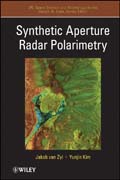
This book describes the application of polarimetric synthetic aperture radar to earth remote sensing based on research at the NASA Jet Propulsion Laboratory (JPL). This book synthesizes all current research to provide practical information for both the newcomer and the expert in radar polarimetry.The textoffers aconcise description of the mathematical fundamentals illustrated with many examples using SAR data, with a main focus onremote sensing of the earth. The book begins with basics of synthetic aperture radar to provide the basis for understanding how polarimetric SAR images are formed and gives an introduction to the fundamentals of radar polarimetry. It goes on to discuss more advanced polarimetric concepts that allow one to infer more information about the terrain being imaged. In order to analyze data quantitatively, the signals must be calibrated carefully, which the book addresses ina chapter summarizing the basic calibration algorithms. The book concludes with examples of applying polarimetric analysis to scattering from rough surfaces, to infer soil moisture fromradar signals. ÍNDICE: Note From the Series Editor xi Foreword xiii Preface xv Acknowledgments xvii Authors xix 1. Synthetic Aperture Radar (SAR) Imaging Basics 1 1.1 Basic Principles of Radar Imaging 2 1.2 Radar Resolution 6 1.3 Radar Equation 10 1.4 Real Aperture Radar 11 1.5 Synthetic Aperture Radar 13 1.6 Radar Image Artifacts and Noise 16 1.7 Summary 22 References 22 2. Basic Principles of SARPolarimetry 23 2.1 Polarization of Electromagnetic Waves 23 2.2 Mathematical Representations of Scatterers 27 2.3 Implementation of a Radar Polarimeter 32 2.4 Polarization Response 34 2.5 Optimum Polarizations 53 2.6 Contrast Enhancement 65 2.7 Summary 71 References 71 3. Advanced Polarimetric Concepts 73 3.1 Vector-Matrix Duality of Scatterer Representation 73 3.2 Eigenvalue- and Eigenvector-Based Polarimetric Parameters 76 3.3 Decomposition of Polarimetric Scattering 88 3.4 Image Classification 125 3.5 Polarimetric SAR Interferometry 1353.6 Summary 141 References 141 4. Polarimetric SAR Calibration 145 4.1 Polarimetric Radar System Model 145 4.2 Cross Talk Estimation and Removal 152 4.3 Copolarized Channel Imbalance Calibration 161 4.4 Absolute Radiometric Calibration 166 4.5 Faraday Rotation 177 4.6 Summary 179 References 180 5. Applications: Measurement of Surface Soil Moisture 182 5.1 Surface Electrical and Geometrical Properties 183 5.2 Scattering from Bare Rough Surfaces 196 5.3 Example Bare Surface Soil Moisture Inversion Models 201 5.4 Comparison of the Performanceof Bare Surface Inversion Models 211 5.5 Parameterizing Scattering Models 2165.6 Inverting the IEM Model 222 5.7 Scattering from Vegetated Terrain 225 5.8Simulation Results 239 5.9 Time Series Estimation of Soil Moisture 252 5.10 Summary 257 References 258 Appendixes A. Tilted Small Perturbation Model Details 262 B. Bistatic Scattering Matrix of a Cylinder with Arbitrary Orientation 267 C. Nomenclature 276 Index 279
- ISBN: 978-1-118-11511-4
- Editorial: John Wiley & Sons
- Encuadernacion: Cartoné
- Páginas: 310
- Fecha Publicación: 30/09/2011
- Nº Volúmenes: 1
- Idioma: Inglés
